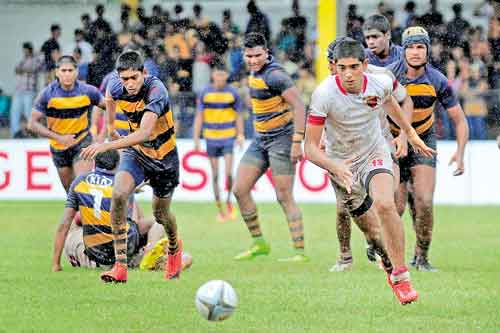Pushing the limits to succeed at any Cost
View(s):
Chasing dreams has now become more competitive - File pic
Bhathiya Ekanayake, a 17-year-old Trinity College Rugby player, withered while at training and later passed away. Various claims have been made as to how the tragic incident occurred. Some say it was during a warm-up, while what looks like a statement by the Principal. says during pre-season training. While offering my deepest sympathies and condolences to the family and joining in the grief of a tragic loss, a few questions nevertheless arise. Fussy words, glossy statements and explanations will, however, not bring Bhathiya back to life.
There are, however, many lessons to be learnt, especially by those who are pushing adolescents in a quasi professional path to win a cup or, those who are promoting their misguided thoughts on success. Those who believe that big budgets mean must win a cup, for which you need to train hard. A question is whether this is the first time students have done grueling runs up and down carrying a burden of weight. I know of a coach who had problems with the old boys, as he refused to replicate these training methods. If one were to look at the ‘Long Term Player Development Plan’ (LTPD), which is now practised in almost all sports, one would understand how to train and not lose one’s life. How can you do this when there are those in the hierarchy who think LTPD is tosh? That is when the world has accepted same through research, and not limited to Rugby.
Question No.1 is the need for such a long aerobic running as a warm-up or, as pre-season training? Are the coaches involved knowledgeable or, certified, to deliver through structured learning and gradual return and improvement. Are these trainers certified and or, qualified to deliver strength and condition sessions for players. Here the question is not limited to Trinity, but an issue that has to be addressed by almost all schools. Is what is done for adult Rugby in New Zealand, Australia, England or Fiji, suitable for local youth?
The introduction to Rugby Ready of the World Rugby (WR) resources says, “Everybody involved in organising Rugby and playing Rugby has a duty of care in relation to players. The Rugby Ready programme is intended to raise awareness of good practice and help stakeholders manage the inherent risks of contact sport.
The guidelines are appropriately headed Rugby Ready – a collective responsibility. There is a checklist that needs to be applied in the pre-participation check. That includes making sure that the player has the attributes and has attained the necessary levels of fitness for his level of play. The profile of a player should include his personal history as well as medical history, including a cardiac questionnaire and lifestyle information. This also requires special attention to age grade players and new players. The content expects coaches to have understanding of the components of fitness that makes a better Rugby player. The components include endurance, speed, strength and functional competence. Tell me, as I stand to be corrected, did this player fall more than once on the route, but was buoyed to continue by the staff and rest of the players. What happened to the basics of player welfare that coaching staff is supposed to know, and also make players understand.
The principles of training require understanding that individuals react to the same training in different ways. Training has to be progressive with time, for rest, recovery and regeneration. This should be followed by a need assessment which has to look at the player’s current condition. I am aware of two incidents at St .Joseph’s and Royal where medical staff refused permission in the past, when players were found wanting medical examinations. They were not allowed to play, despite the parents getting permission from outside medical personnel. I am aware at the Park Club, the pre-season aerobic training is a gradual increase starting from 500m, under the guidance of Sanath Martis, a successful school coach. The question is, as to who in the world gets schoolboys to run over 12 km.
What has to be understood from what happened is that, there should be learning from what has happened. This is more because WR calls its education programmes as being learner centered. We have 3 educators in the coaching stream and 4 in the medical stream. Got to make use of them, as then, we could say a WR pathway was followed. Or else what do we say when there are issues.
Let us first look at the comment that this was a warm-up, which is explained by WR as a vitally important first step to prepare players to perform. The warm-up suggested is between 10 and 20 minutes, depending on what activities are to follow and the climate. A warm-up is about raising body temperature and improving mobility. Then, what is this talk of a 12km run? Or, was it the spirits of the previous nights frolicking.
 Endurance is a key aspect for physical conditioning to Rugby. Was this an endurance test? If this was pre-season training, which mandarin of Rugby asked do a 12km-run. Another question is whether Rugby endurance requires players to train like a long distance runner.
Endurance is a key aspect for physical conditioning to Rugby. Was this an endurance test? If this was pre-season training, which mandarin of Rugby asked do a 12km-run. Another question is whether Rugby endurance requires players to train like a long distance runner.
Rugby is a multi-faceted game played for 80 minutes, and for 70 minutes if it is Under-19s. Does a Rugby player need high endurance levels as would be required by a 5,000m, 10,000m or a marathon runner? Irish Rugby says that a high endurance level in long distance runners is for maintaining a continuous speed/pace effort. According to studies, the average VO2 max for a long distance runner is between 65-80 ml/kg/min, while for a sprinter it is 50-60 ml/kg/min. To a average human being it is 40-45. For Rugby, it differs with a front forward being 45, while a second row or backs 65/ml/kg/min. Rugby is not a continuous game and the aerobic levels are not what is required by long distance runners. Rugby is, therefore, classified as an anaerobic game because of the intermittent high intensity nature, with speed, strength and power dominating. Training must take this into consideration. Is there any logical reason for such long distance running, which has no specificity to Rugby?
Rugby divides training into 3 ‘S’ periods; pre-Season; in-Season; and active rest. Pre-season is a time to regain increase muscle size and strength. It is not prudent to emphasize on aerobic training at this time, as the goal is different. Using interval training to increase endurance would be more appropriate. Irish Rugby says aerobic training is useful, but the coach and player should not overemphasize on this type of training.
A serious analyst of the game, a keen follower but not played Rugby, in hindsight, asked whether Sri Lanka is capable of playing Rugby in a competitive environment. Or, should we go back to the game we played in the ’60s and up to and until the turn of the century. It was Rugby with fun, taken over, at times, by traditional rivalry, both at clubs and schools. It is unlike today, when huge expenses are involved and schoolboys are made semi-professional, that have to perform, the coach who has to show results and the backers who want their pound for spending, irrespective whether it is good for the boy. That is where the politics, power and pervasion enters the gam, was his view.
Vimal Perera is a former Rugby Referee, Coach and an Accredited Referees’ Evaluator IRB


